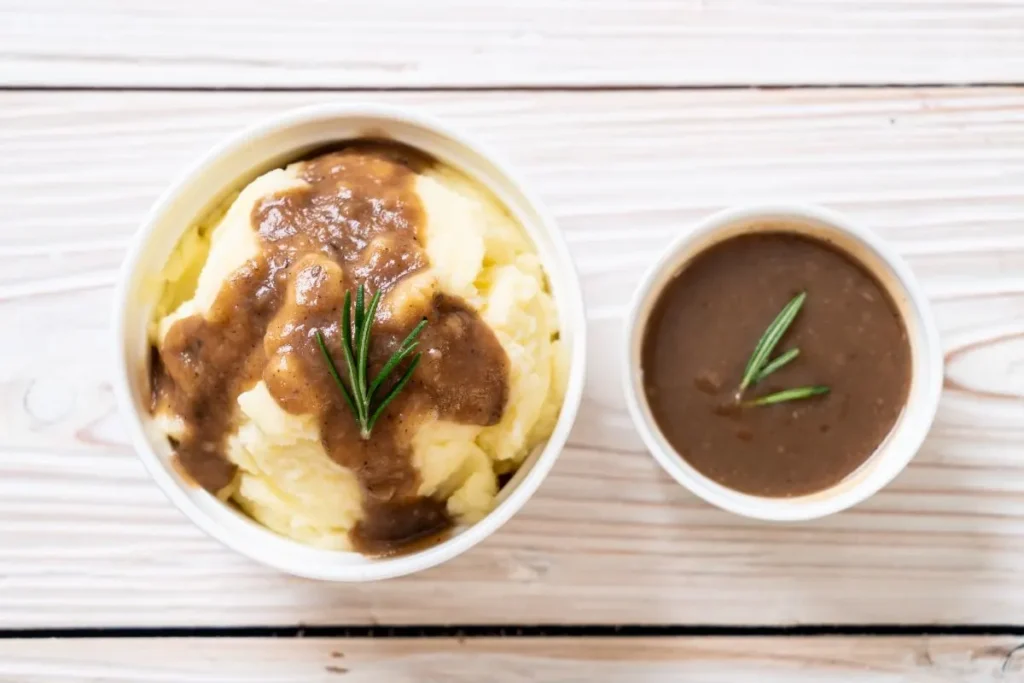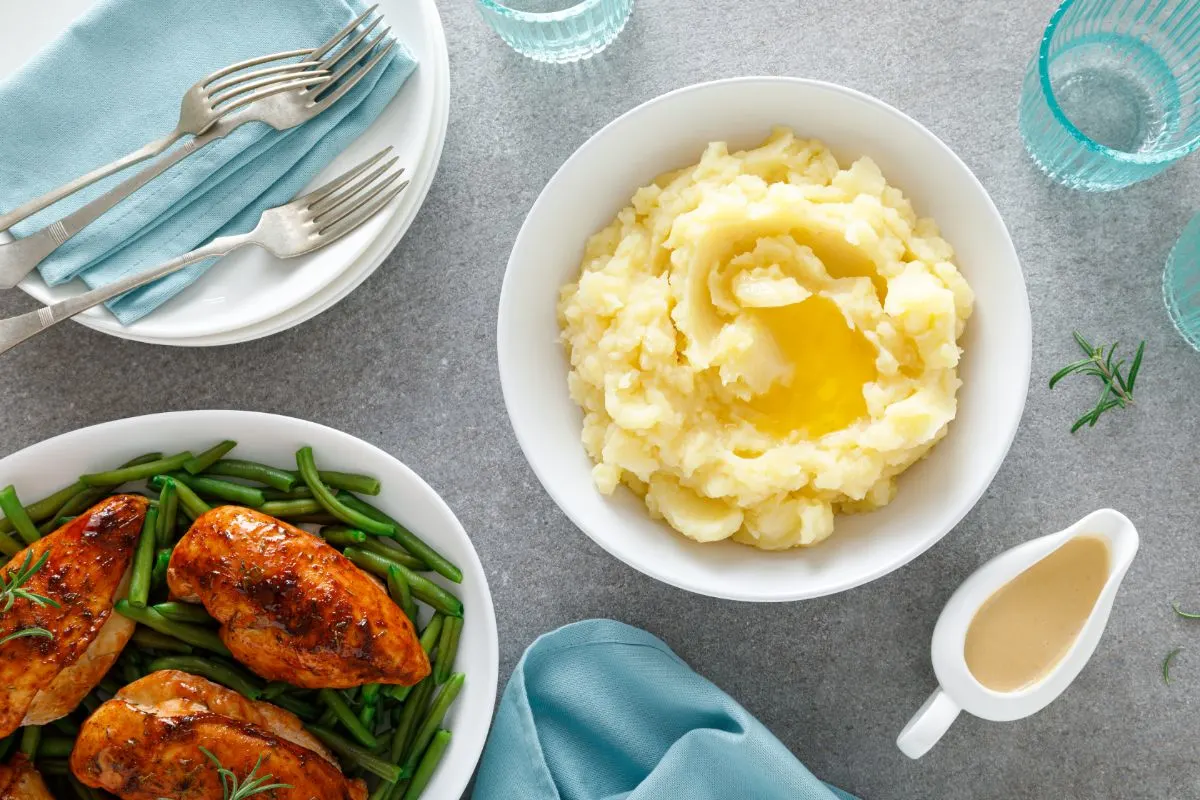Discover everything you need to know about making perfect mashed potatoes and gravy, from recipes to expert tips and nutritional details.
Introduction
Mashed potatoes and gravy are quintessential comfort foods, beloved for their creamy texture and rich, savory flavors. They are staples at holiday dinners, cozy family meals, and celebratory feasts. Despite their widespread popularity, achieving the perfect mash and gravy requires a blend of technique, quality ingredients, and attention to detail. This guide covers everything from the history of mashed potatoes and gravy to expert tips for mastering them at home. Whether you’re a beginner or an experienced cook, this comprehensive guide will help you elevate your mashed potatoes and gravy to culinary perfection.
Table of Contents
A Brief History of Mashed Potatoes and Gravy
Mashed potatoes trace their origins back to the Incas of Peru, who were among the first to cultivate potatoes thousands of years ago. The technique of mashing potatoes spread to Europe in the 16th century, becoming a staple in Ireland and Britain. Meanwhile, gravy—a sauce made from meat drippings—has ancient roots in European and Asian cuisines. Together, mashed potatoes and gravy became popularized in American cooking during the 19th century, evolving into a must-have side dish at Thanksgiving and other traditional meals.
Choosing the Right Ingredients
Best Potatoes for Mashed Potatoes
The type of potato you use is critical to achieving the ideal texture. For creamy mashed potatoes, choose high-starch varieties such as Russet or Yukon Gold potatoes. Moreover, these potatoes break down easily and absorb butter and milk effectively, resulting in a fluffy texture that is both smooth and satisfying. Additionally, for those who prefer a denser mash, combining these with waxy potatoes can create a unique balance of creaminess and texture. Therefore, selecting the right potato is a crucial first step in achieving mashed potato perfection.
For chunkier mashed potatoes, waxy varieties like red or fingerling potatoes work well due to their lower starch content and firmer texture.
Essential Ingredients for Gravy
Gravy requires a balance of fat, flour, and liquid. Essential ingredients include:
- Fat: Butter or pan drippings
- Thickener: All-purpose flour
- Liquid: Chicken, beef, or vegetable stock
- Seasoning: Salt, pepper, and optional herbs like thyme or sage
Complementary Flavors
In addition to the basics, you can enhance your mashed potatoes with:
- Roasted garlic for depth of flavor.
- Fresh herbs like parsley, chives, or dill.
- Cream cheese or sour cream for added richness.
Step-by-Step Recipe: Perfect Mashed Potatoes and Gravy
Ingredients
Mashed Potatoes:
- 2 pounds of Russet or Yukon Gold potatoes
- ½ cup of unsalted butter
- ½ cup of milk (or cream for extra richness)
- 1 teaspoon of salt
- Freshly ground black pepper to taste
Gravy:
- ¼ cup of butter or meat drippings
- ¼ cup of all-purpose flour
- 2 cups of chicken or beef stock
- Salt and pepper to taste
- Optional: 1 teaspoon of fresh thyme
Cooking Instructions
Mashed Potatoes:
- Peel and chop the potatoes into evenly sized chunks.
- Place the potatoes in a large pot, cover with cold water, and add a teaspoon of salt.
- Bring to a boil, then reduce to a simmer and cook until the potatoes are fork-tender (about 15-20 minutes).
- Drain the potatoes and return them to the pot. Mash them using a potato masher or ricer.
- Gradually add butter and milk, mixing until smooth and creamy. Season with salt and pepper to taste.
Gravy:
- In a medium saucepan, melt the butter or heat the pan drippings over medium heat.
- Whisk in the flour and cook for 1-2 minutes to create a roux.
- Slowly add the stock, whisking constantly to prevent lumps.
- Simmer until thickened, about 5 minutes. Add salt, pepper, and optional thyme for flavor.

Tips and Tricks for the Perfect Texture
- Avoid Overmixing: Overmixing mashed potatoes can result in a gummy texture. Use a light hand.
- Warm Ingredients: Heat your milk and butter before adding them to the potatoes for smoother incorporation.
- Strain Your Gravy: For a silky texture, strain your gravy before serving.
- Season at the Right Time: Add salt to the potato water and adjust seasoning after mashing for balanced flavors.
- Use a Ricer or Food Mill: For the fluffiest texture, pass the potatoes through a ricer instead of mashing.
Nutritional Information
Here’s the nutritional breakdown for mashed potatoes and gravy (per 100g):
| Nutrient | Amount |
|---|---|
| Calories | 120 |
| Protein | 2.5g |
| Fat | 6g |
| Carbohydrates | 14g |
| Fiber | 1.5g |
| Sodium | 200mg |
For a well-rounded feast, serve your mashed potatoes alongside roasted Brussels sprouts with Parmesan to add a crispy, savory contrast to your plate.
Popular Variations and Pairings
- Garlic Mashed Potatoes: Add roasted garlic for a bold flavor.
- Herbed Gravy: Incorporate rosemary or parsley into your gravy.
- Loaded Mashed Potatoes: Mix in cheddar cheese, sour cream, and chopped chives.
- Pairings: Serve with roasted turkey, grilled chicken, or steamed vegetables for a complete meal.
Cultural Significance of Mashed Potatoes and Gravy
Mashed potatoes and gravy have become symbolic in American culture, representing comfort, home-cooked meals, and festive gatherings. Furthermore, the dish often takes center stage during Thanksgiving, symbolizing abundance and gratitude, which is a time for reflection and togetherness. Additionally, this pairing has evolved to cater to diverse culinary traditions, making it an integral part of celebrations worldwide. Beyond the United States, variations of mashed potatoes and gravy can be found in cuisines across the globe. For instance, in British cuisine, mashed potatoes often accompany bangers and mash, while in Scandinavian dishes, creamy potatoes pair with rich gravies made from game meats. Consequently, this universal appeal underscores how mashed potatoes and gravy connect people through shared culinary comfort.
Innovative Modern Twists
Vegan Mashed Potatoes and Gravy
Substitute butter with plant-based margarine and use almond or oat milk for creamy mashed potatoes. Additionally, for a dairy-free alternative, almond or oat milk blends seamlessly, creating a velvety texture. For gravy, use olive oil instead of butter and vegetable stock for a flavorful vegan option. Moreover, adding a splash of soy sauce or nutritional yeast to the gravy enhances the umami flavor profile, making it rich and satisfying.
Spicy Mashed Potatoes
Incorporate cayenne pepper, jalapeños, or red chili flakes for a spicy kick to your mashed potatoes. Furthermore, combining these with roasted garlic or smoked paprika can add a layer of complexity to the heat, making the flavor profile more robust. Additionally, consider blending a small amount of melted butter with the spices before mixing them into the potatoes to ensure even distribution of the heat.
Sweet Potato Mash
Swap out traditional potatoes for sweet potatoes to create a healthier and naturally sweet alternative. Moreover, sweet potatoes are packed with nutrients like vitamin A, making them a nutritious choice. Additionally, pair them with a cinnamon-infused gravy for a unique twist that balances sweetness and savory flavors. Furthermore, you can garnish the dish with a sprinkle of toasted pecans or a drizzle of honey for added texture and complexity.
Pair your mashed potatoes and gravy with a side of sweet potato cornbread for a hearty and flavorful addition to any holiday meal.
Pro Tips for Hosting with Mashed Potatoes and Gravy
Storing and reheating mashed potatoes and gravy properly can ensure they remain just as delicious as when freshly made. Here are some essential tips:
Storing Leftovers
- Use Airtight Containers: Transfer mashed potatoes and gravy to separate airtight containers to prevent the flavors from mingling.
- Refrigeration: Store in the refrigerator for up to 3-4 days. Ensure the containers are tightly sealed to prevent the food from drying out.
- Freezing: For longer storage, mashed potatoes can be frozen. Add a bit of cream or butter to help preserve the texture when reheating. Gravy, if made with a flour-based roux, can also be frozen, but avoid freezing gravy thickened with cornstarch as it may separate upon thawing.
Reheating Tips
- Mashed Potatoes:
- Reheat over low heat on the stovetop, adding a splash of milk or cream to restore their creamy consistency.
- Alternatively, use a microwave on medium power, stirring every minute until heated through.
- Gravy:
- Reheat in a saucepan over low heat, whisking continuously to eliminate any lumps and restore the smooth texture.
- Add a small amount of stock or water if the gravy has thickened too much.
Avoid Common Pitfalls
- Do Not Overheat: Overheating can cause the mashed potatoes to become gummy and the gravy to lose its velvety texture.
- Stir Regularly: Regular stirring ensures even heating and prevents sticking or burning.
Proper storage and reheating methods ensure you can enjoy your leftovers without sacrificing flavor or quality.
- Prepare in Advance: You can make mashed potatoes a day ahead and reheat them with a bit of milk and butter.
- Buffet-Friendly: Keep your mashed potatoes warm in a slow cooker to serve a crowd.
- Customizable Toppings: Set up a mashed potato bar with toppings like bacon bits, scallions, shredded cheese, and sour cream.
- Gravy Variations: Offer multiple types of gravy, such as mushroom gravy or onion gravy, to suit different preferences.
FAQ: Your Questions Answered
What is mashed potatoes gravy made of?
Mashed potatoes gravy is made from fat (such as butter or drippings), flour, and stock, seasoned with salt and pepper.
What sauce goes well with mashed potatoes?
Gravy is the classic choice, but other sauces like mushroom sauce or herb butter can also complement mashed potatoes.
Do you eat mashed potatoes with gravy?
Yes, mashed potatoes and gravy are a traditional pairing, especially at holiday meals.
Should you use milk or cream in mashed potatoes?
You can use either milk or cream. Cream adds extra richness, while milk creates a lighter texture.
Conclusion: Bringing It All Together
Mashed potatoes and gravy hold a special place in the world of comfort food, embodying warmth and nostalgia. Perfecting this iconic duo requires attention to detail, from selecting the right ingredients to mastering the cooking techniques. By following this guide, you can create mashed potatoes that are velvety smooth and gravy that’s rich and flavorful, ensuring your meals are nothing short of extraordinary.
Whether served as a side dish at a festive holiday table or as part of a cozy family dinner, mashed potatoes and gravy are a testament to the joy of simple yet indulgent cooking. Experiment with the variations and pairings to make them your own, and enjoy the satisfaction of mastering this timeless dish.

